DIY Interconnect Cables - The "Helix Mark VIII"
Now includes a Balanced design...
The “Helix Mark VIII” represents the very latest developments in researching different wire types and materials. The only difference is that the Mark VII uses Duelund wire for the signal conductor and the Mark VIII uses Mundorf Solid Silver/gold (see below for details)
The premise behind its helical geometry (or architecture) is eliminating parallel conductors, since...
- if two parallel conductors are in close proximity for an extended distance, and current is passed down them, then noise & distortions will occur within them them.
Why would this matter? Isn’t the neutral is effectively connected to the “ground” ?
Well, the neutral conductor is actually connected to the neutral side of the circuit of both attached components.
Any noise permeates through the neutral side of the components circuit, which has a negative impact on the amplified signal resulting in a distorted output.
Any noise in the signal conductor gets amplified and distorted even further
In addition, parallel conductors are prone to Proximity & Skin Effects which alters the resistance of the conductor. affecting the transfer the signal
All of this impacts the phase between the left and right channels, which “smears” the mage.
The helix design concept eliminates the parallel conductors and minimizes the noise, proximity effect and Skin effect to imperceivable levels, improving clarity and dynamic performance of the interconnect.
One other nice feature of the helical design is the neutral conductor, being wound around the signal conductor, becomes a very effective shield against external RFI sources - because it is connected to “ground” ![]()
But Shouldn’t The Two Conductors Be The Same Length?
If you look at the “roles” the two conductors play from the perspective of an attached components’ circuit diagram it becomes clear that cable length is immaterial and they can be made from different materials and gauges.

- The Signal Conductor transfers the signal
- The Neutral Conductor completes the circuit, however, it also connects the neutral sides of the two attached components
- Any “noise” present on the neutral conductor impacts the operation of BOTH components.
For more detailed information on cable design issues please read the three articles below that talk about the many problems that challenge cables builders.
They will provide a great deal of insight into the many parameters and design techniques employed to build cables that excellent in their performance.
https://www.psaudio.com/article/cables-time-is-of-the-essence-part-1/
https://www.psaudio.com/article/cables-time-is-of-the-essence-part-2/
https://www.psaudio.com/article/cables-time-is-of-the-essence-part-3/
How To Make Them...
To determine the “Direction” of the Helix - see Inside The Helix Geometry.
The Single Ended IC Design...
The parts list is reasonably priced between $180 - $250 CDN for a 3ft ( or 1 meter) pair, depending on the RCA’s selected - and all other parts can be purchased from many parts providers on the web.
Considering their exceptional sound quality I believe this price range to be excellent value.
You can upgrade or downgrade these parts if you wish, but the parts listed will provide exceptional sound quality.
I use an approximate ratio of 3:1 of Neutral:Signal conductor
e.g. for a 3ft Interconnect cable I use 9ft of Neutral Conductor
The quantities listed is for a single Interconnect cable i.e. one channel - so double them for a stereo pair
- RCA Plug: KLE Innovations Absolute Harmony RCA Plugs (SOURCE: KLE Innovations or local parts sources)
- Neutral Conductor: 9 ft of Mil Spec 16 AWG Silver Plated Copper Wire Green Cryo Treated (SOURCE: TAKE FIVE AUDIO - TFA)
- Signal Conductor: 3 ft of 20 gauge Duelund stranded Tinned Copper with Oil/Cotton insulation (Source: HiFi Collective). See NOTE A below
- Teflon Tube: 3 ft of PTFE 10 Tubing .106"ID .130"OD Approx. (SOURCE: TFA)
- WBT 4% silver solder
NOTE A: The Signal Conductor
- I have listed the Duelund wire as the signal conductor, but I have found 20 gauge Mundorf Silver/gold solid wire without insulation provides even more details and a stunning image. However, the Mundorf wire is significantly more expensive than the Duelund wire.
Step 1.
I first wind the conductor around a 5mm metal rod. To assist with this I insert the rod into a variable speed hand drill and feed the conductor along its length.
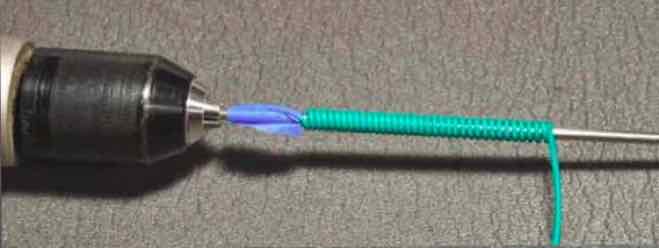
Once wound, the helix can be removed from the dowel.
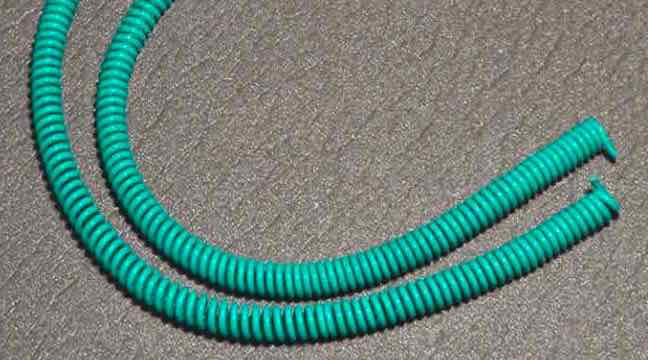
Step 2
Insert the teflon tube into the helix.
Space the windings over the length of the tube
Tighten the helix by twisting it, about an inch at time, along the length of the cable
Secure with a small piece of heat shrink or electrical tape
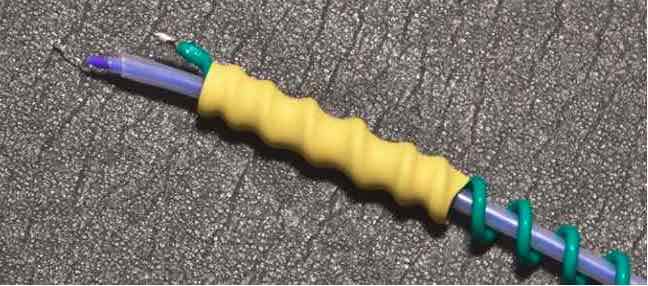
Step 3
Soldering the KLE Innovations needs a little care to prevent excess heat from damaging the plastic housing
I use a chassis mount RCA jack and insert the RCA base into it in order to wick away excess heat
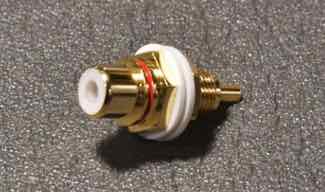
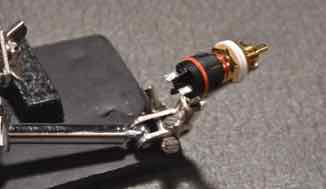
I also use a little “rig” to hold the parts while I solder
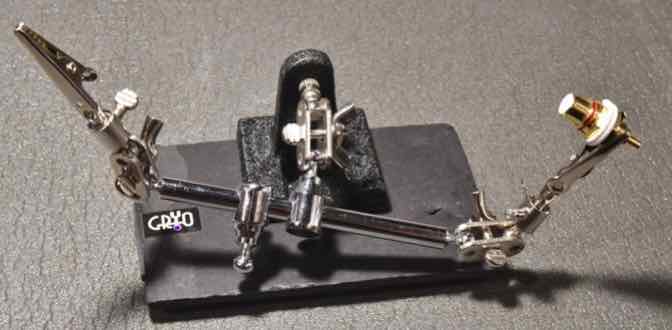
I’ve found that it is easier if I first solder the signal wire to the RCA plug first, followed by the neutral wire
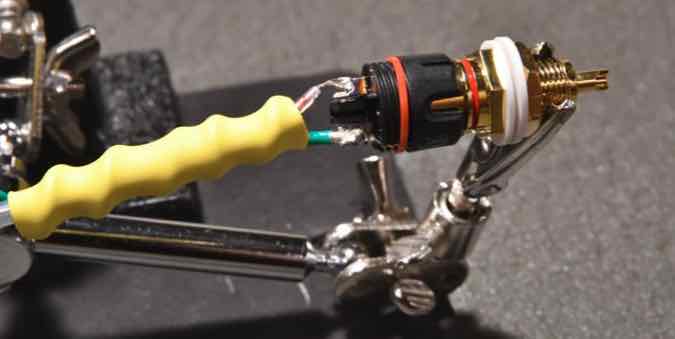
Install the housing of the RCA and tighten the screws
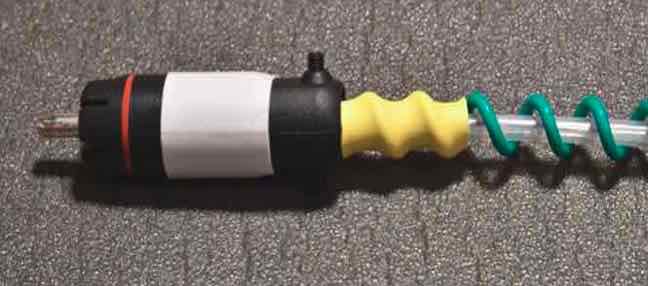
To finish off, you can add some expandable nylon sleeve - it does not impact the performance of the Interconnect.
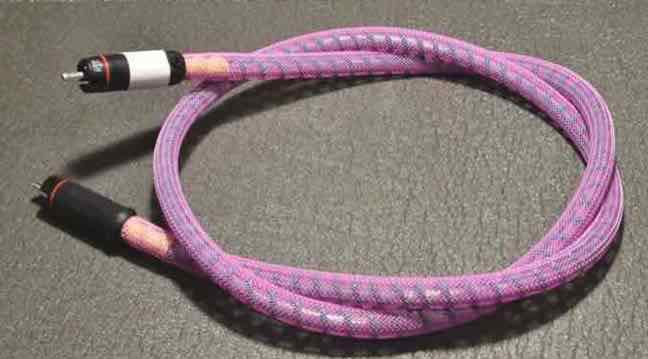
Assembly Notes...
For the budget minded DIYer I have since found that 24 gauge silver plated Mil-Spec wire offers a fuller sound without sacrificing any details and reduced the cost of the cable significantly. I also use it for the neutral.
But for the best performance to date, I now recommend either Mundorf 20 gauge copper wire with oil/cotton insulation or bare Mundorf Solid Silver/Gold(1%) wire.
- Dueund is marginally more expensive than the Mil-Spec wire and is a great performer
- But the Mundorf wire provides the most details and the best imaging,
- They really open up the image and presents a fuller, more detailed image with superb dynamics.
- I only use these wires for for the signal conductor
- I tried the Duelund as the neutral and it did not sound any better than the Mil-spec wire
- I continue to use the Mil-spec wire for the neutral.
I leave it up to you as to which wire you select, but all the wires mentioned above will outperform most of the commercial products currently available
Can you use other brands of RCA?
NOT RECOMMENDED!
I recommend KLE Innovations Harmony RCA’s because of their stellar performance. Personally, I use the Absolute Harmony RCA because it is their best performer.
The properties of the KLEI Harmony RCA’s are very different from conventional RCA’s, such that they can be used on single ended SPDIF cables without experiencing the issues associated with conventional RCA’s not rated at the same impedance as the cable because their impedance exceeds 110 ohms.
e.g. “convention” states that a SPDIF cable should use an RCA plug of identical impedance
Primarily to reduce/eliminate internal “reflections” of the digital signal back down the cable
However, the KLEI Harmony RCA’S can be used on most digital cables regardless of the cables rated impedance value.
I also believe their higher impedance is responsible for their stellar analogue performance.
Can this cable be used for SPDIF purposes?
Absolutely! - it is an extremely adept SPDIF cable!
And I have found that the following cost saving adjustments do not impact SPDIF performance at all...
- KLEI Silver Harmony RCA plugs can be used in place of the more expensive Absolute Harmony RCA plug
- The Silver plated Mi-Spec wire is used for the signal conductor
To date, it is the best SPDIF cable I have used.
What do Helix Mark VIII sound like?
The “Helix Mark VIII” is a very high performance interconnect cable with extremely high resolution capabilities.
They deliver a completely “uncoloured presentation” with ultra fast dynamic performance, exceptional clarity, expansive imaging and a very deep and exceptionally well controlled bass performance.
They excel in the delivery of one of the most realistic presentations of live recordings I have observed.
- The delicate nuances pertaining to the acoustic reverberations of instruments and voice within a live venue are faithfully reproduced in the most minute detail, with a precision placement of musicians and their instruments within their own “virtual space”.
My system components are quite modest by today’s standards. However my cables are all excellent performers and they work in harmony with the components to achieve an excellent overall “system performance”.
Will the “Helix Mark VIII” perform well on all systems?
Based on feedback from people who have made them for some quite varied systems, I have no reason to believe their performance will be anything less than stellar.
The Balanced (XLR) IC Design
The quantities listed is for a single Interconnect cable i.e. one channel - so double them for a stereo pair
- 2 pairs of Neutrik NC3FXX-HA Male/Female XLR Cryo Treated - with Silver Plated Pins ( SOURCE: TAKE FIVE AUDIO - TFA)
- Neutral Conductor: 9 ft of Mil Spec 16 AWG Silver Plated Copper Wire Green Cryo Treated (SOURCE: TAKE FIVE AUDIO - TFA)
- Signal Conductor: 6 ft oof 20 gauge Duelund stranded Tinned Copper with Oil/Cotton insulation (Source: HiFi Collective)
- Outer Teflon Tube: 6 ft of PTFE 10 Tubing .106"ID .130"OD Approx. (SOURCE: TFA)
- WBT 4% silver solder
The Balanced XLR IC design is “basically” the same as single ended design with simple modification.
A balanced cable requires two signal conductors
- one for the positive signal
- one for the negative signal
- Insert the signal conductors in a piece of teflon tube
- gently twist the teflon tubes together - 0ne twist every 5-6 inches
As with the single ended design, wind the neutral conductor in a tight spiral around a dowel
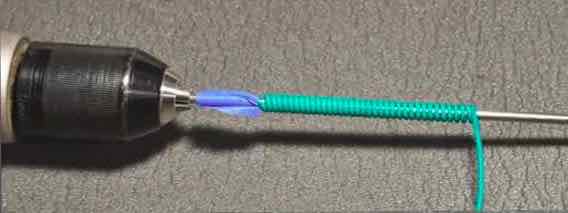
Stretch the spiral a little and then wind the neutral around both the signal conductors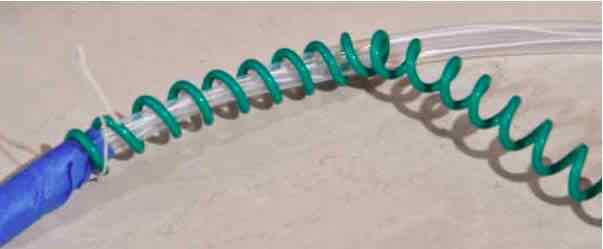
Add the plugs and VOILA!
Nylon Expansion sleeve can be applied to get the “professional look” if desired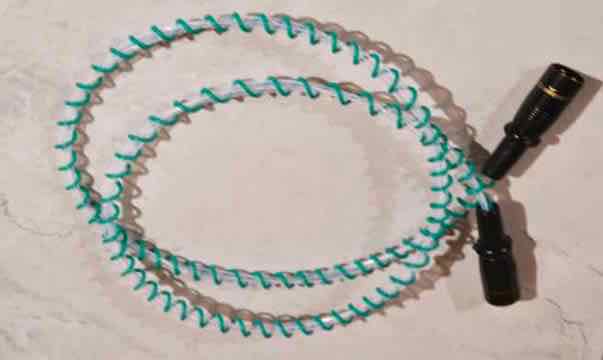
Below is a photo of a completed pair - built by a fellow DIY Audiophile John Tupper - thanks John ![]()
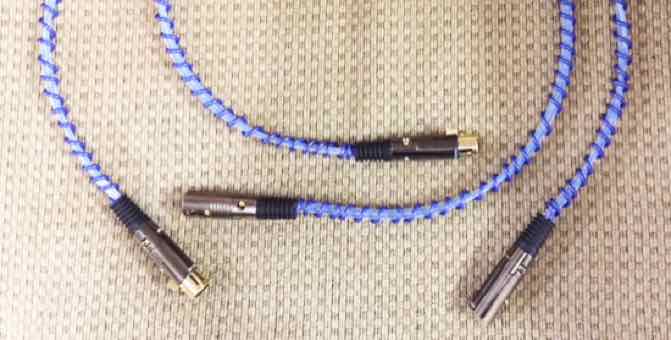
A quote from John,,,
- “My system is now running four of your power cables, XLR interconnects and speaker cables. More burn-in likely required, but, with 72 hours of running they sound fantastic.”
The Journey...
I’m a frugal person with a distinct dislike of overpaying for something as simple as a piece of wire!
I started making my own cables many years ago, but many of those utilized bulk cable from companies like Van den Hul and DH Labs.
I then investigated some of the more recent cable geometries such as tight twisted pairs, braiding and helix geometries.
My biggest issue with helix designs as a DIYer - how to maintain a uniform distance between the signal and neutral conductors - the teflon tubes alleviated this problem
My primary goal along the way was to keep the cost of materials to a minimum.
When I first tried the early CAT6 version of the Helix design it was quite clear that it was going to be a very adept performer.
This observation supported my belief that the Helix architecture (or geometry) was an extremely effective approach to achieving excellent cable performance.
The early versions utilizing CAT6 as the neutral conductor were very good - just not brilliant!
With the “Helix Mark VII” version, I decided to incorporate higher quality silver plated materials in the neutral conductor in the hope that I could come even closer to the performance levels of some of todays popular high performance cables for a fraction of the cost.
The improvements were so good I concluded that a larger gauge neutral conductor provides significant improvements and the Duelund signal conductors were the icing on the cake - and Voila...
the “Helix Mark VII” was born!
The result:
a cable that actually competes with some of the very best cables in the audio world!
C’mon, Really?
- OK, I’ll let you be the final judge, but after listening to many cables I believe this to be the case

How Long is the Burn-In Period?
It is imperative that these cables are allowed adequate time to settle and burn-in, which is typically >300 hours.
- they will however sound extremely good on initial installation
- they may exhibit some loss in volume and image focus after 3-4 days continuous use, but will return to normal by day 6-7
- they will sound exceptional after around 200 hours, but they will get even better after 300 hours
- I have also found ongoing improvements occur up to approximately 600+ hours in the earlier versions
- The use of cable cookers will expedite this process - start with 100 hours cooking + 100 hours playing
The end of the Road?
I have decided to end this particular interconnect cable “obsession” with the “Helix Mark VIII” simply because...
- the cost of better materials is making them significantly more expensive
- the improvements using better materials will probably be marginal from this point onwards
My hope is that this design will be embraced and enhanced by the DIY Community and encourage them to experiment with different conductor materials to tailor the sound to their own liking.
- Since the original posting back in 2015, I have exchanged email with several fellow Diyer’s that have contributed to the Helix design.
- Some people that have contributed to the evolution of the Mark VII design, including: Ernst (Austria), Yordan (Bulgaria), Ghislain (Canada), Todd (USA), John (USA)
For Helix cable spec’s please see Its More Than Just Numbers - Isn't It?
My Review System:
Custom built turntable with a Soundsmith Denon DL103 phono cartridge mounted on an Audiomods Arm with one piece silver litz harness + KLEI Absolute®Harmony RCA’s
Simaudio MOON LP5.3 RS phono stage
Bluesound Node 2 music server
NAIM 5i integrated amp (with passive pre-section).
Gershman Acoustics Sonogram speakers.
KLE Innovations gZero6 Speaker Cables
Assorted power cables
 Give them a try - and - Enjoy The Music!
Give them a try - and - Enjoy The Music! ![]()
ADDENDUM:
Audiogon Member Toddverrone has also tried these IC’s ...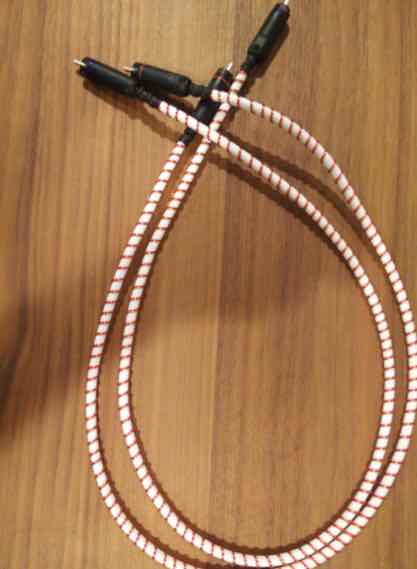
The Parts List :
- signal wire: OCC solid silver 24awg in cotton. 3' per cable
- neutral: OCC solid copper 20awg magnet wire. 2 x 9' per cable
- connectors: KLE pure harmony solid silver
- the white tube is a foamed teflon flexible tube that i ran the signal through. it's pretty amazing. it doesn't kink at all. it's called hyperflex tubing from vh audio
Todd’s Feedback...
I’m still listening to them, but initial findings on the helix ICs are incredibly positive.
More of the helix magic: less noise, greater clarity, better separation of sound sources.
Good stuff!



